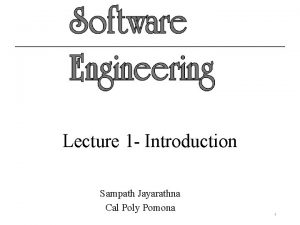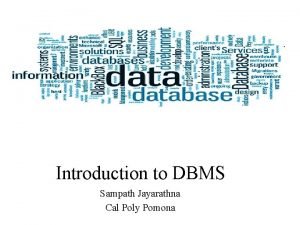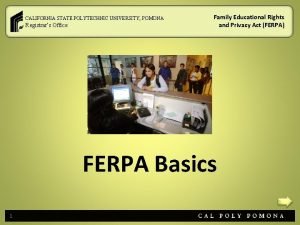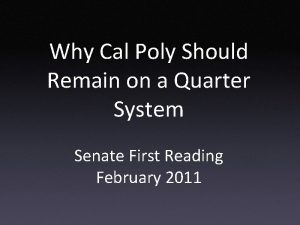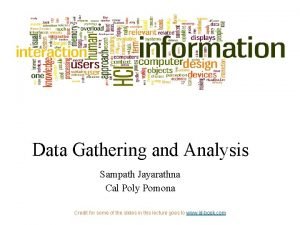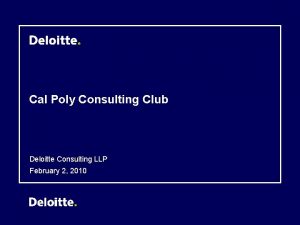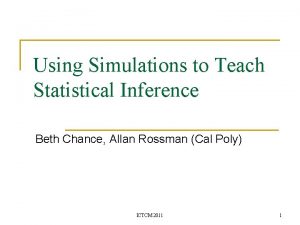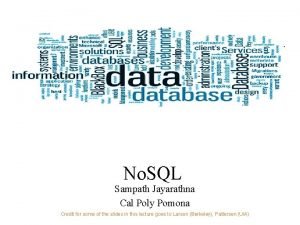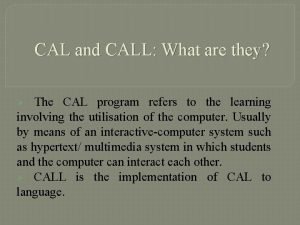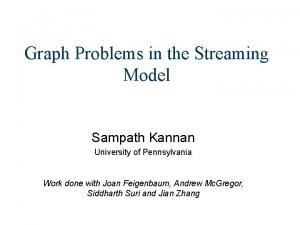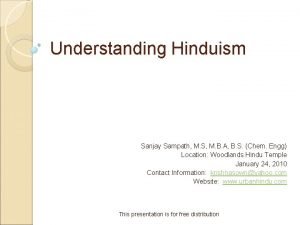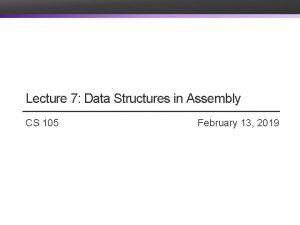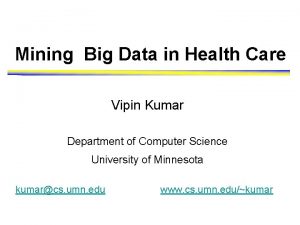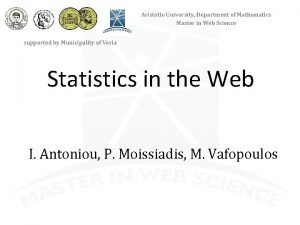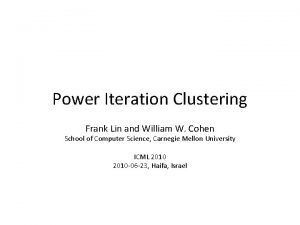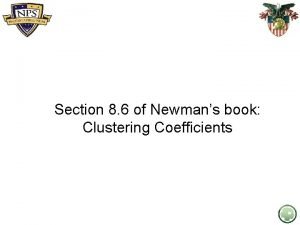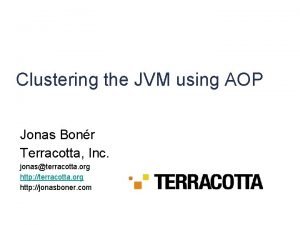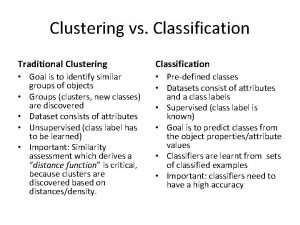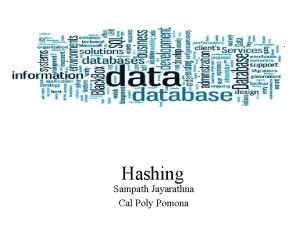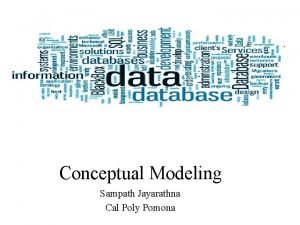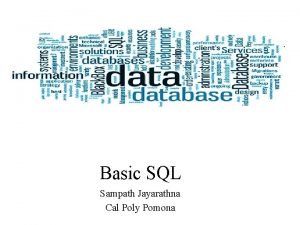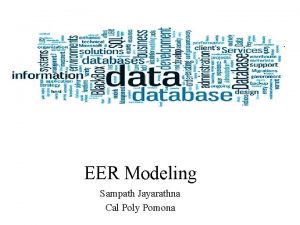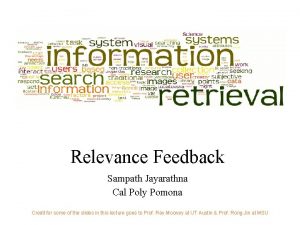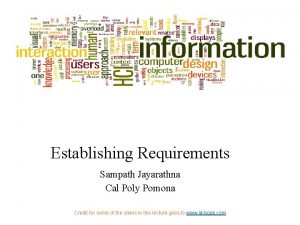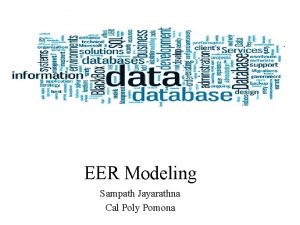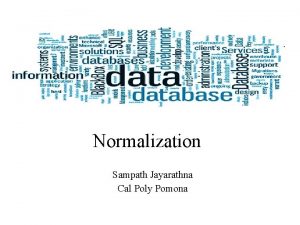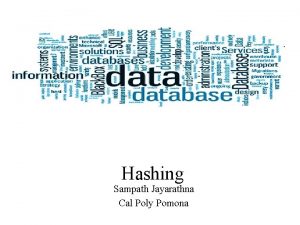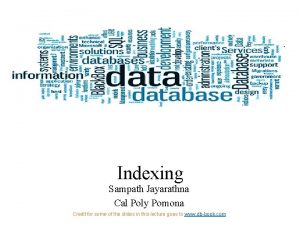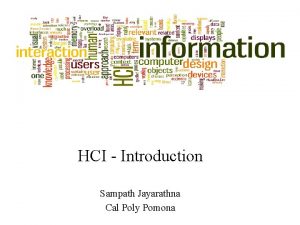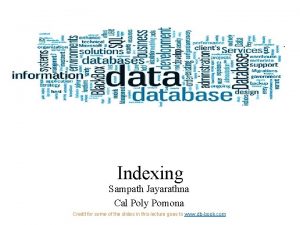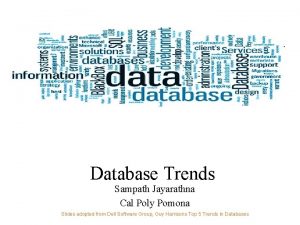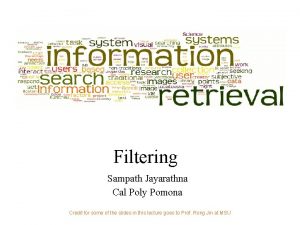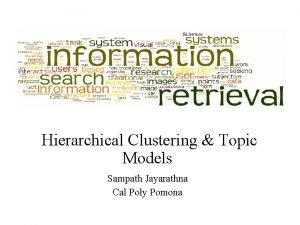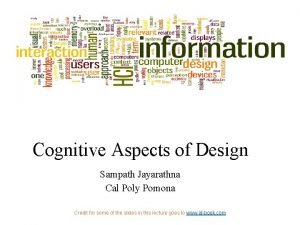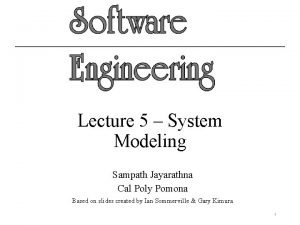Clustering in IR Sampath Jayarathna Cal Poly Pomona




































- Slides: 36

Clustering in IR Sampath Jayarathna Cal Poly Pomona

Take-away today §What is clustering? §Applications of clustering in information retrieval §K-means algorithm §Evaluation of clustering §How many clusters? 2

Clustering: Definition §(Document) clustering is the process of grouping a set of documents into clusters of similar documents. §Documents within a cluster should be similar. §Documents from different clusters should be dissimilar. §Clustering is the most common form of unsupervised learning. §Unsupervised = there are no labeled or annotated data. 3

Data set with clear cluster structure How would you design an algorithm for finding these three clusters? 4

Classification vs. Clustering §Classification: supervised learning §Clustering: unsupervised learning §Classification: Classes are human-defined and part of the input to the learning algorithm. §Clustering: Clusters are inferred from the data without human input. §However, there are many ways of influencing the outcome of clustering: number of clusters, similarity measure, representation of documents, . . 5

Clustering in IR • Result set clustering for better navigation § Yippy (formally Clusty): For grouping search results thematically • Global clustering for improved navigation § Google News: automatic clustering gives an effective 6 news presentation metaphor

Clustering in IR • Visualizing a document collection 7

Sec. 16. 1 For improving search recall • Cluster hypothesis - Documents in the same cluster behave similarly with respect to relevance to information needs • Therefore, to improve search recall: • When a query matches a doc D, also return other docs in the cluster containing D • Hope if we do this: The query “car” will also return docs containing automobile • Because clustering grouped together docs containing car with those containing automobile.

Sec. 16. 1 Issues for Clustering • Representation for clustering • Document representation • Vector space? Normalization? • Need a notion of similarity/distance • How many clusters? • Completely data driven? • Avoid “trivial” clusters - too large or small • In an application, if a cluster's too large, then for navigation purposes you've wasted an extra user click without whittling down the set of documents much.

Consideration for clustering §General goal: put related docs in the same cluster, put unrelated docs in different clusters. §How do we formalize this? §The number of clusters should be appropriate for the data set we are clustering. §Initially, we will assume the number of clusters K is given. §Later: Semiautomatic methods for determining K §Secondary goals in clustering §Avoid very small and very large clusters §Define clusters that are easy to explain to the user 10

Flat vs. Hierarchical clustering §Flat algorithms §Usually start with a random (partial) partitioning of docs into groups §Refine iteratively §Main algorithm: K-means §Hierarchical algorithms §Create a hierarchy §Bottom-up, agglomerative §Top-down, divisive 11

Hard vs. Soft clustering §Hard clustering: Each document belongs to exactly one cluster. §More common and easier to do §Soft clustering: A document can belong to more than one cluster. §Makes more sense for applications like creating browsable hierarchies §You may want to put sneakers in two clusters: §sports apparel §shoes 12

Flat algorithms §Flat algorithms compute a partition of N documents into a set of K clusters. §Given: a set of documents and the number K §Find: a partition into K clusters that optimizes the chosen partitioning criterion §Global optimization: exhaustively enumerate partitions, pick optimal one §Effective heuristic method: K-means algorithm 13

K-means (Hard, flat clustering) §Perhaps the best known clustering algorithm §Simple, works well in many cases §Use as default / baseline for clustering documents §Vector space model §As in vector space classification, we measure relatedness between vectors by Euclidean distance. . . §. . . which is almost equivalent to cosine similarity. 14

K-means § Each cluster in K-means is defined by a centroid. § Objective/partitioning criterion: minimize the average squared difference from the centroid § Recall definition of centroid: § where we use ω to denote a cluster. § We try to find the minimum average squared difference by iterating two steps: • reassignment: assign each vector to its closest centroid • recomputation: recompute each centroid as the average of the vectors that were assigned to it in reassignment 15

Example of k-means • Start with random cluster centers C 1 than to C 2 x 1 x 4 x 3 C 1 C 2 x 5 x 6 x 7

Example of k-means o Identify the points that are closer to C 1 than to C 2 x 1 x 4 x 3 C 1 C 2 x 5 x 6 x 7

Example of k-means • Update C 1 x 2 x 1 x 4 x 3 C 1 C 2 x 5 x 6 x 7

Example of k-means • Identify the points that are closer to C 2 than to C 1 x 2 x 1 x 4 x 3 C 1 C 2 x 5 x 6 x 7

Example of k-means • Identify the points that are closer to C 2 than to C 1 x 2 x 1 x 4 x 3 C 1 x 5 x 6 C 2 x 7

Example of k-means • Identify the points that are closer to C 2 than C 1, and points that are closer to C 1 than to C 2 x 1 x 4 x 3 C 1 x 5 x 6 C 2 x 7

Example of k-means o o Identify the points that are closer to C 2 than C 1, and points that are closer to C 1 than to C 2 Update C 1 and C 2 x 1 C 1 x 4 x 3 x 5 x 6 C 2 x 7

K-means for Clustering • K-means • Start with a random guess of cluster centers • Determine the membership of each data points • Adjust the cluster centers

Optimality of K-means • K-means is guaranteed to converge • But we don’t know how long convergence will take! • If we don’t care about a few docs switching back and forth, then convergence is usually fast (< 10 -20 iterations). • However, complete convergence can take many more iterations. • Convergence does not mean that we converge to the optimal clustering! • This is the great weakness of K-means. • If we start with a bad set of seeds, the resulting clustering can be horrible. 24

Initialization of K-means §Random seed selection is just one of many ways K-means can be initialized. §Random seed selection is not very robust: It’s easy to get a suboptimal clustering. §Better ways of computing initial centroids: §Select seeds not randomly, but using some heuristic (e. g. , document similar to any existing mean) §Try out multiple starting points §Initialize with the results of another method (Use hierarchical clustering to find good seeds) 25

Sec. 16. 3 What Is A Good Clustering? • Internal criterion: A good clustering will produce high quality clusters in which: • the intra-class (that is, intra-cluster) similarity is high • the inter-class similarity is low • The measured quality of a clustering depends on both the document representation and the similarity measure used

Sec. 16. 3 External criteria for clustering quality • Quality measured by its ability to discover some or all of the hidden patterns or latent classes in gold standard data • Assesses a clustering with respect to ground truth … requires labeled data • Assume documents with C gold standard classes, while our clustering algorithms produce K clusters, ω1, ω2, …, ωK with ni members.

Sec. 16. 3 External Evaluation of Cluster Quality • Simple measure: purity, the ratio between the dominant class in the cluster cj and the size of cluster ωi

Example for computing purity good_docs(ω1) = max(5, 1, 0) = 5 good_docs(ω2) = max(1, 4, 1) = 4 good_docs(ω3) = max(2, 0, 3) = 3 Purity(Ω) = (1/17) × (5 + 4 + 3) = 12/17 ≈ 0. 71. 29

Rand index § Definition: § Based on 2 x 2 contingency table of all pairs of documents: § § TP+FN+FP+TN is the total number of pairs. There are pairs for N documents. Example: = 136 in o/⋄/x example Each pair is either positive or negative (the clustering puts the two documents in the same or in different clusters). . . §. . . and either “true” (correct) or “false” (incorrect): the clustering decision is correct or incorrect. 30

Rand Index: Example As an example, we compute RI for the o/⋄/x example. We first compute TP + FP. The three clusters contain 6, 6, and 5 points, respectively, so the total number of “positives” or pairs of documents that are in the same cluster is: Of these, the x pairs in cluster 1, the o pairs in cluster 2, the ⋄ pairs in cluster 3, and the x pair in cluster 3 are true positives: Thus, FP = 40 − 20 = 20. How to calculate FN and TN? 31

Rand measure for the o/⋄/x example 32

Rand measure for the o/⋄/x example RI = (20 + 72)/(20 + 24 + 72) ≈ 0. 68. 33

F measure § F measure • • Like Rand, but “precision” and “recall” can be weighted P = tp/(tp + fp) = 20/40 = 0. 5 R = tp/(tp + fn) = 20/44 = 0. 45 Fβ=1 = 2*P*R/(P+R) = 0. 45/0. 95 = 0. 47 34

Evaluation Results All 3 measures range from 0 (really bad clustering) to 1 (perfect clustering) 35

How many clusters? § Number of clusters K is given in many applications. § What if there is no external constraint? Is there a “right” number of clusters? § One way to go: define an optimization criterion • Given docs, find K for which the optimum is reached. 36
 Cal poly pomona software engineering
Cal poly pomona software engineering Oracle cal poly pomona
Oracle cal poly pomona Cal poly pomona registrar's office
Cal poly pomona registrar's office Cal poly pomona finance
Cal poly pomona finance Cal poly pomona dietetic internship
Cal poly pomona dietetic internship Cal poly quarter or semester
Cal poly quarter or semester Processing
Processing Flat vs hierarchical clustering
Flat vs hierarchical clustering Divisive hierarchical clustering example
Divisive hierarchical clustering example Rumus distance
Rumus distance Chantal huynh
Chantal huynh Quantitative analysis cal poly
Quantitative analysis cal poly Cal poly bike lockers
Cal poly bike lockers Cal poly academic personnel
Cal poly academic personnel Evd deloitte
Evd deloitte Ortak portal
Ortak portal Cal poly triathlon
Cal poly triathlon Beth chance cal poly
Beth chance cal poly Construction management cal poly
Construction management cal poly Frank owen cal poly
Frank owen cal poly Cal poly database
Cal poly database About me
About me Cal and cal
Cal and cal Sampath kannan
Sampath kannan P sampath
P sampath Sanjay sampath
Sanjay sampath Srinidhi sampath kumar
Srinidhi sampath kumar Cs105 pomona
Cs105 pomona Ramaquois
Ramaquois Pomona pd news
Pomona pd news Pomona workday
Pomona workday Disadvantages of k means clustering
Disadvantages of k means clustering Global clustering coefficient
Global clustering coefficient Ncut
Ncut Global clustering coefficient
Global clustering coefficient Shadow and bonr
Shadow and bonr Clustering vs classification
Clustering vs classification
